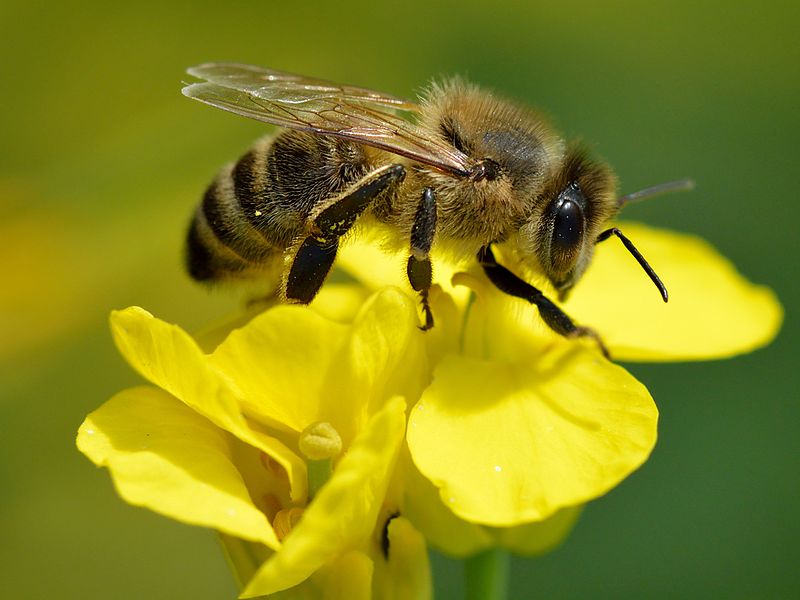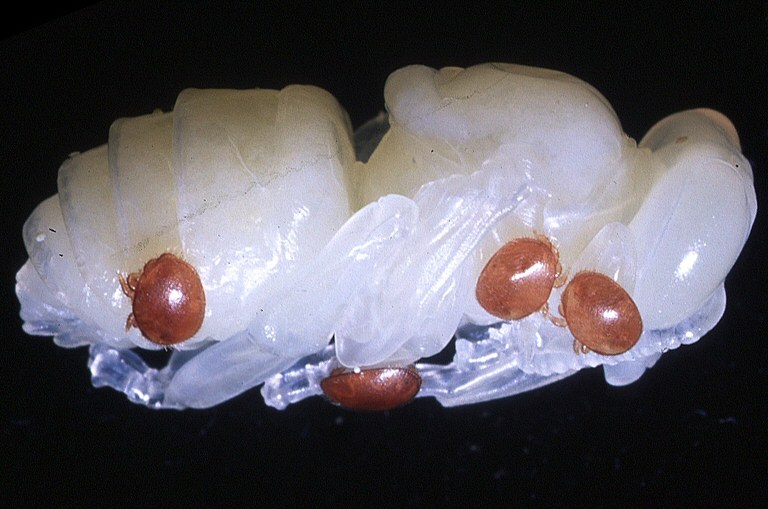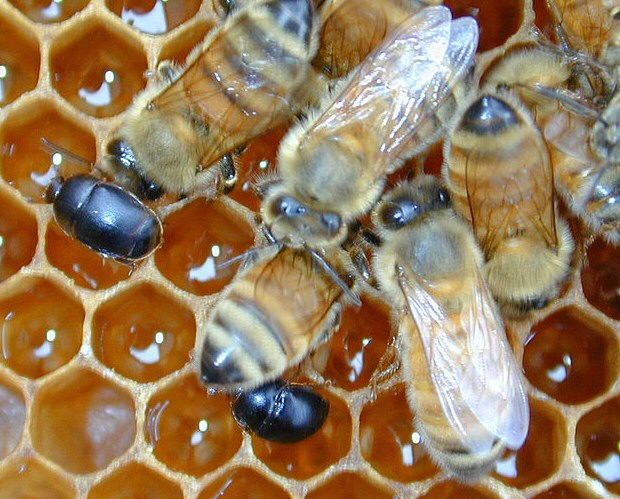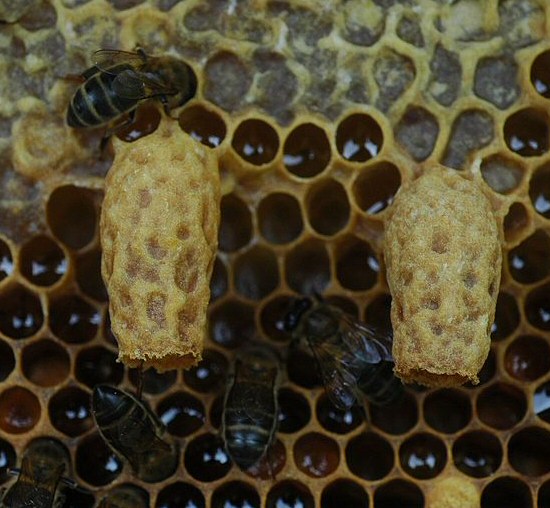- Home
- Garden Wildlife
- Insects
- Hymenoptera
- Honeybee
Honeybees
The honeybee will take nectar and pollen from a wide range of garden plants and is generally the type of bee most frequently seen in gardens.
Species in Britain and Ireland
There is only one species of honeybee, Apis mellifera, in Britain and Ireland, of the 7 species and 44 subspecies globally. This bee probably originated in Africa or Asia and now occurs throughout Europe. It has been introduced to many other parts of the world. Honeybees are kept in hives in gardens and other apiaries. Feral colonies may take up residence in hollow trees, roof spaces and disused chimneys. Nowadays, wild colonies die out after a few years because of a parasitic mite, Varroa destructor, that feeds on honeybee larvae and pupae, and increases the spread of damaging virus diseases within the bee colony.
Varroa originates from south east Asia, where it lives in relative harmony with another species of honeybee, Apis cerana. When the European honeybee was taken to Asia, the mite was able to transfer to Apis mellifera colonies, which are much less able to tolerate the mite. Since then, Varroa destructor has spread to most countries where the European honeybee occurs, being first discovered in England in 1992. It is now widespread in Britain and Ireland. It is possible to keep Varroa infestations at a low level in hives managed by beekeepers but feral colonies succumb when mite numbers and virus infections reach a critical level.
Other threats to the honeybee are small hive beetle, Aethina tumida, and the Asian hornet, Crabro velutina. The latter preys on adult honeybees and will enter weakened hives to take the larvae and pupae. Asian hornets came from China and have become widespread in France since arrival there in 2004. There have been a total of 101 confirmed sightings of Asian hornet in the UK since 2016. This figure includes a total of 85 nests, all of which were destroyed. The small hive beetle and its larvae tunnel through bee comb, causing it to disintegrate. It originates from southern Africa and was found in southern Italy in 2014. There is considerable concern that it may become established in the UK.
Mating with virgin queens is about the only task that male honeybees perform. At the end of summer, there are no virgin queens, so drones become redundant. In August, worker bees use their jaws to drag drones out of the hive and they prevent them re-entering. Unable to fend for themselves, the drones die of cold or starvation.
The queen’s principal role is to lay eggs, which she can do at a rate of more than a thousand a day in early summer. Her other main function is to produce scents or pheromones that tell the other bees in the colony that the queen is alive and well. Worker bees lick the queen’s body to pick up what is called queen substance. The chemicals in queen substance spread throughout the colony when the bees transfer food between each other. If a queen dies, the colony will be aware within a few hours and steps will be taken to start producing a new queen.
In winter, when temperatures are low and there are few plants in flower, honeybees remain inside their hives. They form a dense cluster of bees on the combs instead of being dispersed over the combs as they are in summer. They consume the honey they stored in the combs during the summer and this sustains them until spring allows them to forage again.
Life cycle
A honeybee colony behaves like a superorganism, since despite a colony containing many thousands of bees there is only one fertile female that can lay eggs. The queen begins laying eggs in late winter and reaches a peak of egg production in early summer. Egg laying then slows down and stops in late autumn. Queen honeybees have the option of laying either fertilised eggs or unfertilised eggs. The latter will develop into male bees, known as drones, while fertilised eggs will become worker bees or queens.
In early-mid summer, the honeybee colony may become overcrowded, or the queen may have become old and is unable to produce enough queen substance to maintain control over the colony. The worker bees will then produce special wax queen cells. Eggs laid in these cells will hatch into larvae that are given extra food compared to larvae from similar eggs laid in ordinary worker bee cells. This results in the adult queen bee being a larger female with functioning ovaries.
When the new queens are ready to emerge from their cells, the bee colony become agitated and about half the worker bees and the old queen leave the hive in a swarm. The swarm settles in a cluster on a nearby tree or shrub, with the worker bees being attracted to the queen by her scent. Scout bees from the swarm will go out to try and locate a new home for the swarm. When a likely hollow tree or other suitable cavities have been located, the scouts return to the swarm and perform waggle dances to encourage other bees to visit the potential new homes. Somehow a consensus on the new home is achieved and the swarm will then move off to take up residence.



![Photo: The Packer Lab - Bee Tribes of the World [Attribution]](images/800px-Apis_mellifera_Male.jpg)
![Photo: Bienenkoenigin_43a.jpg: Waugsbergderivative work: B kimmel [CC BY-SA 3.0 (http://creativecommons.org/licenses/by-sa/3.0/)], via Wikimedia Commons](images/800px-Bienenkoenigin_43a_cropped.jpg)
Above left: Bee pupa with four Varroa mites. Above right: Comb and worker bees with 2 Small hive beetles
Biology
The honeybee is a social insect that lives in colonies headed by a single fertile female known as the queen. All of the other bees in the hive are her offspring. In mid summer, when the colony is likely to be at peak strength, there may be up to 60,000 worker honeybees, which are infertile females, and several hundred males, known as drones.
Above left: Queen bee with workers. Note her large size and long abdomen. Centre: Worker bee on rape flower. Right: Drone. Drone is larger than the worker, with a relatively short fat abdomen.
As the name worker implies, the worker bees do most of the tasks necessary for the colony to function. They produce the wax that is made into wax comb where nectar and pollen is stored and the larvae are reared. Propolis is made by worker bees by mixing wax with tree exudate, and is used as a glue to seal small gaps in the hive, it hardens when cold. Worker bees guard the hive against intruders, when necessary using their stings. The workers go out to visit flowers to collect nectar and pollen. They sometimes also collect other sweet liquids, such as fruit juices, contents of discarded drink cans and honeydew excreted by aphids. Back in the hive, nectar and other sweet liquids are processed by enyzmes secreted by the bees and excess water is evaporated off to produce honey, which is stored in the wax combs.
Worker bees are able to communicate to other bees the whereabouts of a good source of nectar or pollen. They do this by performing a ‘figure of eight waggle dance’ on the vertical face of the bee comb. A dancing bee is surrounded by other worker bees, which deduce the distance and direction of the food source by the speed of the dance and the angle of the dance relative to the vertical.
YouTube video of waggle dance by Bienentanz GmbH
Click to start the video
Above left: Special queen brood cells on the comb. Right: Swarming bees. With no hive to protect, swarming bees are reluctant to sting, although the appearance of a swarm can be rather frightening.
Meanwhile, back in the hive, young queens are emerging. Before they can become functioning queens, they need to mate. On warm sunny days, virgin queens fly out of the hive and will mate with several drones while flying high in the sky. On returning to the hive, the mated young queens will fight amongst themselves until there is just one queen that will take over the colony. In strong colonies, there may be one or more smaller swarms or casts emerging from the hive after the prime swarm has left with the old queen. These casts are often headed by virgin queens. Sometimes an old queen will be replaced by a new queen without swarming. This is known as "supersedure" and generally occurs in late summer.
Role of the honeybee in gardens
Honeybees have to visit flowers in order to collect the nectar and pollen that is used to feed themselves and their larvae. When a worker bee pushes her mouthparts into flowers to suck up nectar, the hairy head and body picks up pollen grains. When the bee moves to another flower of the same plant, some of this pollen rubs off onto the stigma of the flower, thus bringing about pollination. Honeybees, along with other types of bee and some other insects, are needed by many plants to bring about pollination and allow them to produce fruits and seeds. Most of the fruits and some vegetables grown in gardens require pollination by insects and will produce a poor crop if they are not pollinated.
Some conservation concern has been raised, that honeybee cpolonies, which are human-managed domestic stock, could compete and depress the success of wild bees and other pollinators. The evidence suggests this is not a strong effect.
Honeybees also produce food for us in the form of honey. A productive beehive can produce more than 100 pounds of honey during the summer. Beeswax has many uses, including candle making and as an ingredient of hand creams and furniture polishes. Propolis has been used in traditional medicine, and has become fashionable within alternate medicine circles, believed (with little evidence) to have anti-inflammatory, antibacterial, antiviral and antifungal powers.
Sources of information
Website
Website of the British Beekeepers Association
Books
Aston, D. & Bucknall, S. (2004) Plants and Bees. Northern Bee Books
Davis, I. & Cullum-Kenyon, R. (2012) BBKA Guide to Beekeeping. Bloomsbury
De Bruyn, C. (1997) Practical Beekeeping. Crowood Press
Hooper, T. (2010) Bees and Honey. Northern Bee Books
Kirk, W. D. J. & Howes, F. N. (2012) Plants for Bees. International Bee Research Association
By Andrew Halstead reviewed by Andrew Salisbury edited by Steve Head
_swarming_(12-17-2016)_patagonia_lake,_santa_cruz_co,_az_-01_(31898126911).jpg)

Honeybees
The honeybee will take nectar and pollen from a wide range of garden plants and is often the type of bee most frequently seen in gardens.
Species in Britain and Ireland
There is only one species of honeybee, Apis mellifera, in Britain and Ireland, of the 7 species and 44 subspecies globally. This bee probably originated in Africa or Asia and now occurs throughout Europe. It has been introduced to many other parts of the world. Honeybees are kept in hives in gardens and other apiaries. Feral colonies may take up residence in hollow trees, roof spaces and disused chimneys. Nowadays, wild colonies die out after a few years because of a parasitic mite, Varroa destructor, that feeds on honeybee larvae and pupae, and increases the spread of damaging virus diseases within the bee colony.
Varroa originates from south east Asia, where it lives in relative harmony with another species of honeybee, Apis cerana. When the European honeybee was taken to Asia, the mite was able to transfer to Apis mellifera colonies, which are much less able to tolerate the mite. Since then, Varroa destructor has spread to most countries where the European honeybee occurs, being first discovered in England in 1992. It is now widespread in Britain and Ireland. It is possible to keep Varroa infestations at a low level in hives managed by beekeepers but feral colonies succumb when mite numbers and virus infections reach a critical level.
Other threats to the honeybee are small hive beetle, Aethina tumida, and the Asian hornet, Crabro velutina. The latter preys on adult honeybees and will enter weakened hives to take the larvae and pupae. Asian hornets came from China and have become widespread in France since arrival there in 2004. There have been a total of 101 confirmed sightings of Asian hornet in the UK since 2016. This figure includes a total of 85 nests, all of which were destroyed. The small hive beetle and its larvae tunnel through bee comb, causing it to disintegrate. It originates from southern Africa and was found in southern Italy in 2014. There is considerable concern that it may become established in the UK.



Above left: Bee pupa with four Varroa mites. Above right: Comb and worker bees with 2 Small hive beetles
Biology
The honeybee is a social insect that lives in colonies headed by a single fertile female known as the queen. All of the other bees in the hive are her offspring. In mid summer, when the colony is likely to be at peak strength, there may be up to 60,000 worker honeybees, which are infertile females, and several hundred males, known as drones.
![Photo: The Packer Lab - Bee Tribes of the World [Attribution]](images/800px-Apis_mellifera_Male.jpg)
![Photo: Bienenkoenigin_43a.jpg: Waugsbergderivative work: B kimmel [CC BY-SA 3.0 (http://creativecommons.org/licenses/by-sa/3.0/)], via Wikimedia Commons](images/800px-Bienenkoenigin_43a_cropped.jpg)
Above left: Queen bee with workers. Note her large size and long abdomen. Centre: Worker bee on rape flower. Right: Drone. Drone is larger than the worker, with a relatively short fat abdomen.
As the name worker implies, the worker bees do most of the tasks necessary for the colony to function. They produce the wax that is made into wax comb where nectar and pollen is stored and the larvae are reared. Propolis is made by worker bees by mixing wax with tree exudate, and is used as a glue to seal small gaps in the hive, it hardens when cold. Worker bees guard the hive against intruders, when necessary using their stings. The workers go out to visit flowers to collect nectar and pollen. They sometimes also collect other sweet liquids, such as fruit juices, contents of discarded drink cans and honeydew excreted by aphids. Back in the hive, nectar and other sweet liquids are processed by enyzmes secreted by the bees and excess water is evaporated off to produce honey, which is stored in the wax combs.
Worker bees are able to communicate to other bees the whereabouts of a good source of nectar or pollen. They do this by performing a ‘figure of eight waggle dance’ on the vertical face of the bee comb. A dancing bee is surrounded by other worker bees, which deduce the distance and direction of the food source by the speed of the dance and the angle of the dance relative to the vertical.
YouTube video of waggle dance by Bienentanz GmbH
Click to start the video
Above left: Special queen brood cells on the comb. Right: Swarming bees. With no hive to protect, swarming bees are reluctant to sting, although the appearance of a swarm can be rather frightening.
Meanwhile, back in the hive, young queens are emerging. Before they can become functioning queens, they need to mate. On warm sunny days, virgin queens fly out of the hive and will mate with several drones while flying high in the sky. On returning to the hive, the mated young queens will fight amongst themselves until there is just one queen that will take over the colony. In strong colonies, there may be one or more smaller swarms or casts emerging from the hive after the prime swarm has left with the old queen. These casts are often headed by virgin queens. Sometimes an old queen will be replaced by a new queen without swarming. This is known as supersedure and generally occurs in late summer.
Role of the honeybee in gardens
Honeybees have to visit flowers in order to collect the nectar and pollen that is used to feed themselves and their larvae. When a worker bee pushes her mouthparts into flowers to suck up nectar, the hairy head and body picks up pollen grains. When the bee moves to another flower of the same plant, some of this pollen rubs off onto the stigma of the flower, thus bringing about pollination. Honeybees, along with other types of bee and some other insects, are needed by many plants to bring about pollination and allow them to produce fruits and seeds. Most of the fruits and some vegetables grown in gardens require pollination by insects and will produce a poor crop if they are not pollinated.
Some conservation concern has been raised, that honeybee cpolonies, which are human-managed domestic stock, could compete and depress the success of wild bees and other pollinators. The evidence suggests this is not a strong effect.
Honeybees also produce food for us in the form of honey. A productive beehive can produce more than 100 pounds of honey during the summer. Beeswax has many uses, including candle making and as an ingredient of hand creams and furniture polishes. Propolis has been used in traditional medicine, and has become fashionable within alternate medicine circles, believed (with little evidence) to have anti-inflammatory, antibacterial, antiviral and antifungal powers.
Sources of information
Website
Website of the British Beekeepers Association
Books
Aston, D. & Bucknall, S. (2004) Plants and Bees. Northern Bee Books
Davis, I. & Cullum-Kenyon, R. (2012) BBKA Guide to Beekeeping. Bloomsbury
De Bruyn, C. (1997) Practical Beekeeping. Crowood Press
Hooper, T. (2010) Bees and Honey. Northern Bee Books
Kirk, W. D. J. & Howes, F. N. (2012) Plants for Bees. International Bee Research Association
By Andrew Halstead reviewed by Andrew Salisbury edited by Steve Head
_swarming_(12-17-2016)_patagonia_lake,_santa_cruz_co,_az_-01_(31898126911).jpg)

Mating with virgin queens is about the only task that male honeybees perform. At the end of summer, there are no virgin queens, so drones become redundant. In August, worker bees use their jaws to drag drones out of the hive and they prevent them re-entering. Unable to fend for themselves, the drones die of cold or starvation.
The queen’s principal role is to lay eggs, which she can do at a rate of more than a thousand a day in early summer. Her other main function is to produce scents or pheromones that tell the other bees in the colony that the queen is alive and well. Worker bees lick the queen’s body to pick up what is called queen substance. The chemicals in queen substance spread throughout the colony when the bees transfer food between each other. If a queen dies, the colony will be aware within a few hours and steps will be taken to start producing a new queen.
In winter, when temperatures are low and there are few plants in flower, honeybees remain inside their hives. They form a dense cluster of bees on the combs instead of being dispersed over the combs as they are in summer. They consume the honey they stored in the combs during the summer and this sustains them until spring allows them to forage again.
Life cycle
A honeybee colony behaves like a superorganism, since despite a colony containing many thousands of bees there is only one fertile female that can lay eggs. The queen begins laying eggs in late winter and reaches a peak of egg production in early summer. Egg laying then slows down and stops in late autumn. Queen honeybees have the option of laying either fertilised eggs or unfertilised eggs. The latter will develop into male bees, known as drones, while fertilised eggs will become worker bees or queens.
In early-mid summer, the honeybee colony may become overcrowded, or the queen may have become old and is unable to produce enough queen substance to maintain control over the colony. The worker bees will then produce special wax queen cells. Eggs laid in these cells will hatch into larvae that are given extra food compared to larvae from similar eggs laid in ordinary worker bee cells. This results in the adult queen bee being a larger female with functioning ovaries.
When the new queens are ready to emerge from their cells, the bee colony become agitated and about half the worker bees and the old queen leave the hive in a swarm. The swarm settles in a cluster on a nearby tree or shrub, with the worker bees being attracted to the queen by her scent. Scout bees from the swarm will go out to try and locate a new home for the swarm. When a likely hollow tree or other suitable cavities have been located, the scouts return to the swarm and perform waggle dances to encourage other bees to visit the potential new homes. Somehow a consensus on the new home is achieved and the swarm will then move off to take up residence.












